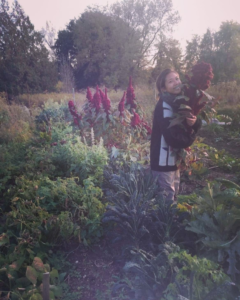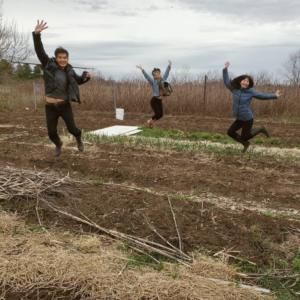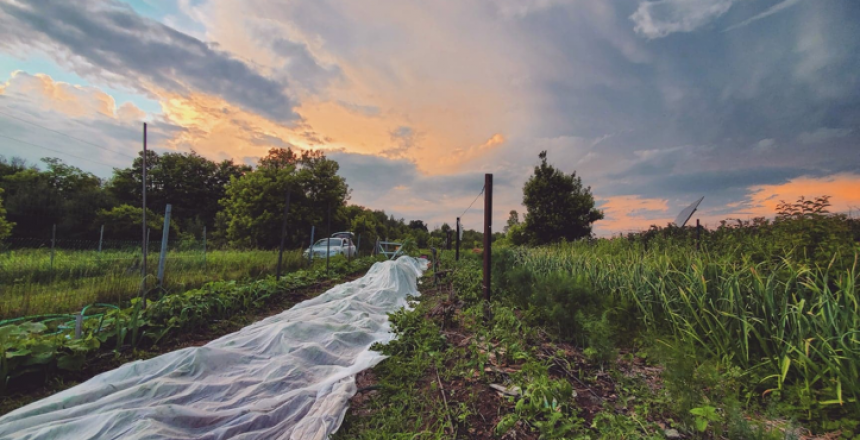“A foundational idea for us is that healing and justice might be possible at individual and community levels by fostering connection, mindfulness, and compassion.”
In this interview series, I’m featuring extraordinary leaders and social impact organizations that are making an impact in their communities.
Littlefoot Community Projects is a not-for-profit organization, based out of Kitchener-Waterloo, Canada. Their mission is aimed at relieving poverty through the power of food by making healthy food accessible. They work with a range of community members to address diverse aspects of food security, including: basic income, health care, education, sustainable agriculture, land & food sovereignty, culturally appropriate foods, and more.
I spoke with Vanessa Ong, one of the co-founders. Vanessa and I have a shared volunteer engagement history with Oxfam Canada. We were both on the Strategy and Support Team from 2016-2017 where we acted as leaders and mentors to Oxfam Campus groups across Canada. Throughout this time, I got to see Vanessa as an empathetic, driven and inspiring leader in action. So it’s no surprise that she’s brought passion and fire to this organization.
There’s a special place in my heart for community-driven impact projects. I’ve followed her work with this organization over the past couple of years as it’s blossomed (pun intended). And I’ve been encouraged by their commitment to harness food as an avenue to alleviate poverty. Here’s a bit of their story:
1. Where did the idea for the name “Littlefoot Community Projects” come from?
V.O: Our name emerged from careful thought about our intentions and approaches to community food work. On one level, it points to the idea of reducing the ecological footprint of our growing practices and throughout our whole operation. It also reflects on the philosophies of the Vietnamese poet and spiritual leader, Thich Nhat Hanh, who has many writings on how to cultivate peace through awareness of relationships and of the world around us. I love the idea of walking meditation as a way of awakening, and to dissolve the illusion that we are in some way separate from others and from the Earth. An influential novel for me in particular was Nhat Hanh’s, “Peace is Every Step”, where he writes: “Peace is already present in each step, and if we walk in this way, a flower will bloom under our feet with every step. In fact the flowers will smile at us and wish us well on our way”. A foundational idea for us is that healing and justice might be possible at individual and community levels by fostering connection, mindfulness, and compassion.
2. Littlefoot Community Projects seems to be the “little-big” engine that could! I remember when you first launched, and it seems as though you’re only growing. What do you credit for your growth and succession?
V.O.: Our development owes to the support, commitments, energy, and graciousness of incredible humans and organizations in our community! We are so privileged to be informally sharing land with a local hobby farmer, who doesn’t charge us for rent or utilities. Access to land is commonly a huge barrier for young farmers/food justice groups, so this piece is crucial. Our personal and professional relationships with groups like Hacienda Sarria Market Garden, KW Habilitation, Emmanuel United Church, Fresh Ground Cafe, and Full Circle Foods (to name a few) also allow us to explore socially innovative ideas related to food security and to connect with underserved communities.
3. What’s it like being the co-founder of a social impact, community organization?
V.O.: It is both heartwarming and exhausting. Because this work is unfunded, I work a full-time job alongside managing Littlefoot. Also, my personality is to pour myself into my passions, and this translates into constant researching, reflecting, community outreach, (un)learning, and (over)thinking. I do think that these are good qualities to have, but managing burnout is also lifelong work for me.
4. What do you believe are the biggest barriers to food security and how does your organization address it?
V.O.: That’s a tough one: food security is dynamic and multifaceted. However, I would acknowledge that food security encompasses physical/geographic accessibility, affordability, stability of food resources, and availability of culturally appropriate foods. It is deeply intertwined with entrenched societal problems: poverty and unemployment, racism, and inequality. These aren’t simple issues to grapple with, but our organization has set itself up to actively address food insecurity in an intersectional way. We are really intentional about engaging in diverse partnerships and advocacy, and we mindfully design our programs and activities.
5. How do you address the causes of food insecurity in an intersectional way?
V.O.: Well, first I’d like to name Crenshaw for coining the term intersectionality to analyze social problems and people as multifaceted, specifically from the lens of critical race theory. I think first and foremost, intersectionality in our work is about identifying the complexities of food insecurity, and also shedding light on the humanity of the subject. We know from research that in Canada, indigenous populations, racialized populations, and low income populations are disproportionately affected by food insecurity. So it’s really important to understand how various inequalities intersect, overlap, and cascade in intricate ways.
On the ground, it means we work hard to be politically engaged, addressing both social and environmental issues in our work. Our pay what you choose markets are designed to counteract rising food costs in Downtown Kitchener. We have a wide range of partners, allowing us to connect with people of different life situations who have fallen into food insecurity for a whole host of reasons. Racialized people also face unique issues related to food access, food shame, and cultural food availability, so integrating a racial and food justice lens is foundational for us.
6. You grow so many amazing things from yummy greens (spinach) to practical compost tea. What is your growing strategy? Is it based by season, community needs, etc?
V.O.: Littlefoot grows using a “small-plot intensive” model and regenerative agricultural practices. This basically means our farming principles aim to build up the health of the soil, increase biodiversity, improve climate change resilience in the food system, reduce degradation, and of course promote both ecological and social health in the process. Our work is largely seasonal in nature, but we hope to find funding for a greenhouse to extend our growing season – this is important in terms of being able to supply our community with food stably, throughout the year.
Because of how we started this work, we chose to grow based on what grows well here and what we know best. However, we have actively communicated with our partners and even distributed surveys to help guide our crop plans over the years. It’s a constant learning process and as we engage with different neighbourhoods and partner organizations, I think our chosen crops will change accordingly.
7. Tell me more about the pay-what-you-can market model.
V.O.: This model was directly influenced by the suggestions of my Masters research participants, who identify as low-income, longtime residents of Kitchener-Waterloo. This model began to solidify throughout my qualitative interview process, as I was conducting research on food security in relation to gentrification in the Downtown Kitchener core. I shared many conversations with residents about rising food prices, the symbolic changes around healthy foods, and cultural shifts occurring in the Downtown. The pay-what-you-can (PWYC) model was one specific suggestion to address equity and the redistribution of wealth/resources. In the summer of 2019, we piloted a PWYC market at Fresh Ground Cafe, a project of a key social service organization in Kitchener, The Working Centre. They offered free vending space every Saturday, making it accessible to us as a small not-for-profit.
We carefully designed the project to ensure clarity and sensitivity. Suggested price ranges were displayed with our veggies to give customers an idea of what they want to pay in comparison to grocery store prices. A pay box was displayed so that customers could make a payment without telling us what they are paying, encouraging dignity or at least anonymity in the transaction.
We’ve learned a lot along the way in terms of marketing and pricing. Recently, we also made the decision to shift toward the terminology “pay-what-you-choose” in attempts to reduce stigma and empower customers in their financial decision-making at our markets!

8. What would you tell someone who is interested in starting up a community focused, social impact organization?
V.O.: I guess I would encourage a lot of self reflection in terms of why you are entering into social impact work, and where your intentions rest – charity is unsustainable, and our societies have a lot of learning to do in terms of addressing systemic social and environmental issues. Stay self-reflexive in your work, constantly checking your privilege(s) and positionality in your pursuits. And connect with all of the different minds and hidden pockets of different demographics in your community to guide your work…I think social impact work should always be in flux, it’s an ongoing conversation and learning process.
9. What are you most proud of in your Littlefoot journey so far? And what are your organization goals for the future?
V.O.: I’m proud of the unique partnerships that we have developed over time, because they enable us to explore socially innovative ideas in different ways. On a more personal level, I’ve also approached this work with a lot of introspection on how food has influenced my identity; in terms of experiences of food shame in my predominantly white, suburban hometown, as well as deep nostalgia, memories linking family and food, and pride. So, I was really proud when my Tsoi-Sum greens finally grew, and it was so satisfying to eat something from the garden that was culturally/mentally familiar.
In the future, we have a garden expansion in mind, so we have goals to grow in size and to extend our garden season in order to produce food year-round. Part of this is to create employment opportunities at a living wage for community members, and maybe even pay ourselves a little bit. More importantly, we want to keep connecting with our community, learning about the needs of food insecure populations, and building a strengthened food justice movement in Kitchener-Waterloo

